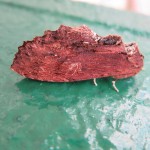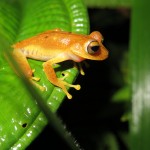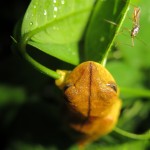Hello, Everyone – here’s the latest info on what’s been happening and what’s been seen around the Fundación’s land in the amazing Corredor Ecológico Llanganates-Sangay (CELLS). This corridor was the first to be nominated as such, in Ecuador, in January 1996 and we are proud to be helping protect and preserve this very important ecological site.
This month, in addition to the many regularly-spotted animals and plants seen in, on and around the land, have been seen the following:
A banded coral pipe snake (Anilius scytale) which is rarely seen, and by some scientists thought no longer living in this part of Ecuador. This has now been seen twice by us on the land over a period of three years and has attracted the interest of herpetologists from Quito who we hope will join us for further investigation.
The black-eared fairy (Heliothryx auritus) which is a medium-sized tropical hummingbird. It has bright green upperparts, white underparts and a black mask.
The Wattled Guan (Aburria aburri ) which is is a large bird with a long tail, about 75 centimetres (30 in) long and weighing between 1,200 and 1,550 grams (42 and 55 oz). The plumage is black, the beak is blue and the feet are flesh-coloured. The International Union for the Conservation of Nature (IUCN) has assessed its conservation status as being “near threatened“.
The silver-tipped myotis (Myotis albescens) which is a species of mouse-eared bat found in a range of lowland habitats in the Americas.
And last, though by no means least! – a two metre long Bushmaster snake (Lachesis muta) was found at the roadside below the Fundación’s land and was rescued and released on the land up by the river. The bushmaster, like other pit vipers, has a special adaptation that helps them detect their warm-blooded prey. They have two heat-sensitive pits, one on each side of their heads, halfway between their eye and nostril. These pits allow the snake to sense the heat difference between a small mammal and the cooler rocks, plants and other objects in the area. It was a very healthy specimen and not too pleased to be handled. However, had it not been moved, and had almost any of the neighbours come by, it would not have survived. They are known to be rather venomous.
An estimated 130 different species of birds have been seen or heard, in, on, around and above the land – which is around 10% of the total for the whole of Ecuador!
We have, (mainly thanks to Glen!) managed to hold our Asemblea General (Annual General Meeting) for 2016 really early this year. Our accounts, annual report and work plans for the year were all fully approved and the elected Equipo Directivo (Management Committee) from the last AGM (held in December last year) confirmed in post. One amendment to note is that Carolina Socola was appointed to the committee in December when our long-standing supporter Fausto Muñoz stood down. Many thanks to Fausto for his committment and hard work on our behalf over the years and hopefully he will continue to be an active member of the group.
On the land, work has continued on moving materials thanks to Cyclops and his aides. We recently had a delivery of a lorry-load of sand to the entrance to the land and this is well on the way up to where the construction of the toilet/shower block is to be located. Plans are continuing and clearing also, around this area; general maintenance work has also been happening. We reckon to be looking at a filtered water system for the toilets/shower, and hope to be able to start further work on this very soon.



